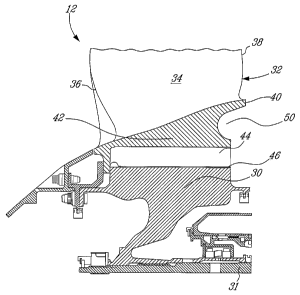Some of the information on this Web page has been provided by external sources. The Government of Canada is not responsible for the accuracy, reliability or currency of the information supplied by external sources. Users wishing to rely upon this information should consult directly with the source of the information. Content provided by external sources is not subject to official languages, privacy and accessibility requirements.
Any discrepancies in the text and image of the Claims and Abstract are due to differing posting times. Text of the Claims and Abstract are posted:
| (12) Patent: | (11) CA 2566527 |
|---|---|
| (54) English Title: | NATURAL FREQUENCY TUNING OF GAS TURBINE ENGINE BLADES |
| (54) French Title: | REGLAGE DE LA FREQUENCE NATURELLE DES AUBES DE MOTEURS A TURBINE A GAZ |
| Status: | Granted |
| (51) International Patent Classification (IPC): |
|
|---|---|
| (72) Inventors : |
|
| (73) Owners : |
|
| (71) Applicants : |
|
| (74) Agent: | NORTON ROSE FULBRIGHT CANADA LLP/S.E.N.C.R.L., S.R.L. |
| (74) Associate agent: | |
| (45) Issued: | 2012-04-17 |
| (86) PCT Filing Date: | 2005-05-11 |
| (87) Open to Public Inspection: | 2005-11-24 |
| Examination requested: | 2009-06-09 |
| Availability of licence: | N/A |
| (25) Language of filing: | English |
| Patent Cooperation Treaty (PCT): | Yes |
|---|---|
| (86) PCT Filing Number: | PCT/CA2005/000721 |
| (87) International Publication Number: | WO2005/111377 |
| (85) National Entry: | 2006-11-14 |
| (30) Application Priority Data: | ||||||
|---|---|---|---|---|---|---|
|
A gas turbine engine blade (32), such as a swept fan blade, having a tuning
notch (50) machined in the back of a blade root (42) between a platform (40)
and dovetail (44). Proper sizing and location of the notch allow for the
natural frequency of the blade to be modified. In this way, the notch can be
designed to alter the natural frequency of the blade so as to avoid
coincidence with the known aerodynamic excitation frequencies while not
effecting blade aerodynamics. An associated method of tuning the natural
frequency of a gas turbine blade is also disclosed.
Une aube de turbine à gaz (32) telle qu'une aube de soufflante à aubes variables comporte une encoche de réglage (50) usinée dans la partie arrière, à la racine (42) de l'aube, entre une plate-forme (40) et une queue d'aronde (44). Le choix approprié des dimensions et de l'emplacement de l'encoche permettent de modifier la fréquence naturelle de l'aube. De cette manière, l'encoche peut être conçue pour modifier la fréquence naturelle de l'aube de façon à éviter toute coïncidence avec des fréquences d'excitation aérodynamique sans affecter pour autant l'aérodynamique de l'aube. L'invention concerne aussi un procédé correspondant de réglage de la fréquence naturelle de l'aube d'une turbine à gaz.
Note: Claims are shown in the official language in which they were submitted.
Note: Descriptions are shown in the official language in which they were submitted.

For a clearer understanding of the status of the application/patent presented on this page, the site Disclaimer , as well as the definitions for Patent , Administrative Status , Maintenance Fee and Payment History should be consulted.
| Title | Date |
|---|---|
| Forecasted Issue Date | 2012-04-17 |
| (86) PCT Filing Date | 2005-05-11 |
| (87) PCT Publication Date | 2005-11-24 |
| (85) National Entry | 2006-11-14 |
| Examination Requested | 2009-06-09 |
| (45) Issued | 2012-04-17 |
There is no abandonment history.
| Fee Type | Anniversary Year | Due Date | Amount Paid | Paid Date |
|---|---|---|---|---|
| Registration of a document - section 124 | $100.00 | 2006-11-14 | ||
| Application Fee | $400.00 | 2006-11-14 | ||
| Maintenance Fee - Application - New Act | 2 | 2007-05-11 | $100.00 | 2006-11-14 |
| Maintenance Fee - Application - New Act | 3 | 2008-05-12 | $100.00 | 2008-03-11 |
| Maintenance Fee - Application - New Act | 4 | 2009-05-11 | $100.00 | 2009-05-11 |
| Request for Examination | $200.00 | 2009-06-09 | ||
| Maintenance Fee - Application - New Act | 5 | 2010-05-11 | $200.00 | 2010-05-07 |
| Maintenance Fee - Application - New Act | 6 | 2011-05-11 | $200.00 | 2011-05-11 |
| Final Fee | $300.00 | 2012-01-31 | ||
| Maintenance Fee - Application - New Act | 7 | 2012-05-11 | $200.00 | 2012-01-31 |
| Maintenance Fee - Patent - New Act | 8 | 2013-05-13 | $200.00 | 2013-04-10 |
| Maintenance Fee - Patent - New Act | 9 | 2014-05-12 | $200.00 | 2014-04-09 |
| Maintenance Fee - Patent - New Act | 10 | 2015-05-11 | $250.00 | 2015-04-23 |
| Maintenance Fee - Patent - New Act | 11 | 2016-05-11 | $250.00 | 2016-04-22 |
| Maintenance Fee - Patent - New Act | 12 | 2017-05-11 | $250.00 | 2017-04-20 |
| Maintenance Fee - Patent - New Act | 13 | 2018-05-11 | $250.00 | 2018-04-19 |
| Maintenance Fee - Patent - New Act | 14 | 2019-05-13 | $250.00 | 2019-04-19 |
| Maintenance Fee - Patent - New Act | 15 | 2020-05-11 | $450.00 | 2020-04-23 |
| Maintenance Fee - Patent - New Act | 16 | 2021-05-11 | $459.00 | 2021-04-22 |
| Maintenance Fee - Patent - New Act | 17 | 2022-05-11 | $458.08 | 2022-04-21 |
| Maintenance Fee - Patent - New Act | 18 | 2023-05-11 | $473.65 | 2023-04-19 |
| Maintenance Fee - Patent - New Act | 19 | 2024-05-13 | $473.65 | 2023-12-18 |
Note: Records showing the ownership history in alphabetical order.
| Current Owners on Record |
|---|
| PRATT & WHITNEY CANADA CORP. |
| Past Owners on Record |
|---|
| STONE, PAUL |